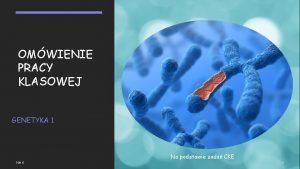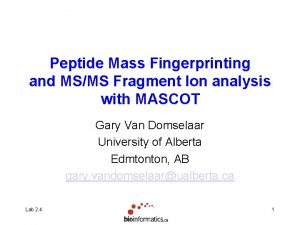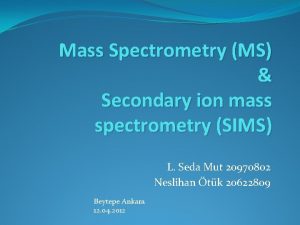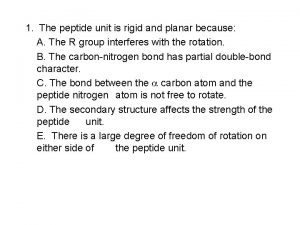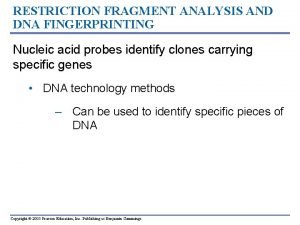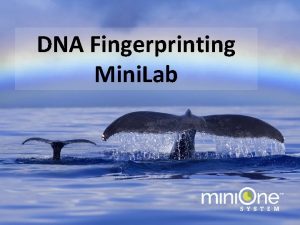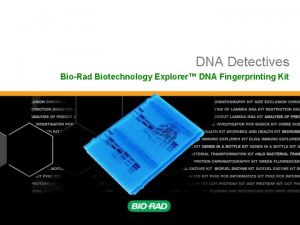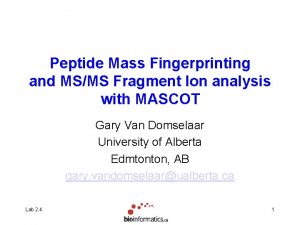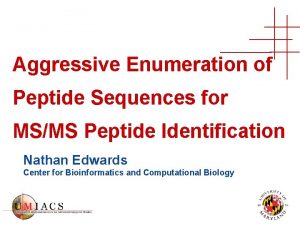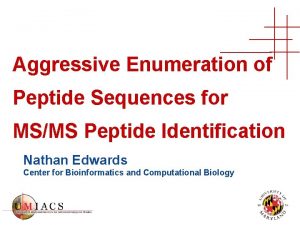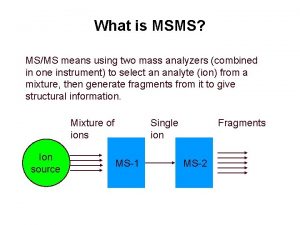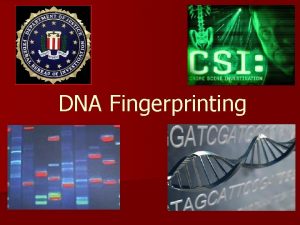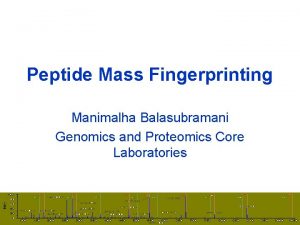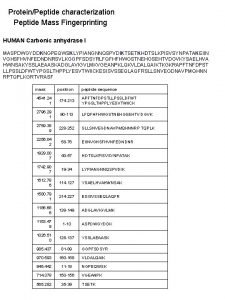Peptide Mass Fingerprinting and MSMS Fragment Ion analysis

















- Slides: 17

Peptide Mass Fingerprinting and MS/MS Fragment Ion analysis with MASCOT Gary Van Domselaar University of Alberta Edmtonton, AB gary. vandomselaar@ualberta. ca Lab 2. 4 1

Review: Peptide Mass Fingerprinting Complex Protein Mixture 2 D Gel Purified Proteolysis Peptide Separation Protein Digest MALDI Mass Spec Lab 2. 4 2

Review: MS/MS Fragment Ion Analysis Complex Protein Proteolysis Mixture Lab 2. 4 Peptide Digest HPLC MS/MS 3

MASCOT Lab 2. 4 4

MOWSE • MOlecular Weight SEarch • Scoring based on peptide frequency distribution from the OWL non redundant Database Pappin DJC, Hojrup P, and Bleasby AJ (1993) Rapid identification of proteins by. Bleasby peptide-mass fingerprinting. Curr. Biol. 3: 327 -332 Lab 2. 4 5

MOWSE Lab 2. 4 6

MOWSE Lab 2. 4 7

MOWSE Lab 2. 4 Mol. Wt. 2098. 8909 1183. 5266 1007. 4251 722. 3508 Fragment IVTMEEEWENDADNFEK DFQEASDFPK ACEDFHSAK QWFEL 1740. 7500 1407. 6460 1456. 6127 722. 3508 DFHSADFQEASDFPK IVTMEEEWENK DADNFEQWFEK QWFEI 8

MOWSE Lab 2. 4 9

MOWSE Lab 2. 4 10

MOWSE Lab 2. 4 11

MOWSE 1740. 7500 1456. 6127 722. 3508 0. 5 x 1 = 0. 5 Lab 2. 4 12

MOWSE PN = product of distribution frequency scores = 0. 5 x 1 = 0. 5 H = 'Hit' Protein MW = 5672. 48 = Lab 2. 4 50 000 = 17. 62 0. 5 x 5672. 48 13

MOWSE Takes into account relative abundance of peptides in the database when calculating scores. Protein size is compensated for. The model consists of numerous spaces separated by 100 Da (the average aa mass). Does not provide a measure of confidence for the prediction. • MOWSE • http: //www. hgmp. mrc. ac. uk/Bioinformatics/Webapp/mowse/ • MS-Fit • http: //prospector. ucsf. edu/ucsfhtml 3. 2/msfit. htm Lab 2. 4 14

MASCOT • Probability-based MOWSE • The probability that the observed match between experimental data and a protein sequence is a random event is approximately calculated for each protein in the sequence database. Probability model details not published. Perkins DN, Pappin DJC, Creasy DM, and Cottrell JS (1999) Probability-based protein identification by searching sequence databases using mass spectrometry data. Electrophoresis 20: 3551 -3567. Lab 2. 4 15

Mascot/Mowse Scoring • The Mascot Score is given as S = -10*Log(P), where P is the probability that the observed match is a random event Lab 2. 4 16

Mascot Scoring – The Mascot Score is given as S = -10*Log(P), where P is the probability that the observed match is a random event – The significance of that result depends on the size of the database being searched. Mascot shades in green the insignificant hits using a P=0. 05 cutoff. In this example, scores less than 74 are insignificant Mascot Score: 120 = 1 x 10 -12 Lab 2. 4 17
 Podaj oznaczenie literowe nukleozydu
Podaj oznaczenie literowe nukleozydu Lc msms
Lc msms Msms icys
Msms icys L/c
L/c Mascot peptide mass fingerprint
Mascot peptide mass fingerprint Ejemplo de fuerza ion ion
Ejemplo de fuerza ion ion Ion dipolo
Ion dipolo Dipolos instantaneos
Dipolos instantaneos Induced dipole induced dipole interaction
Induced dipole induced dipole interaction Mass spectrometer process
Mass spectrometer process Rigid and planar
Rigid and planar Dna fragment length
Dna fragment length Rflp analysis
Rflp analysis Lausd fingerprinting
Lausd fingerprinting A plain arch is the simplest of all fingerprint patterns.
A plain arch is the simplest of all fingerprint patterns. Dna fingerprinting minilab answers
Dna fingerprinting minilab answers Dna fingerprinting lab answer key
Dna fingerprinting lab answer key Biorad dna fingerprinting
Biorad dna fingerprinting
